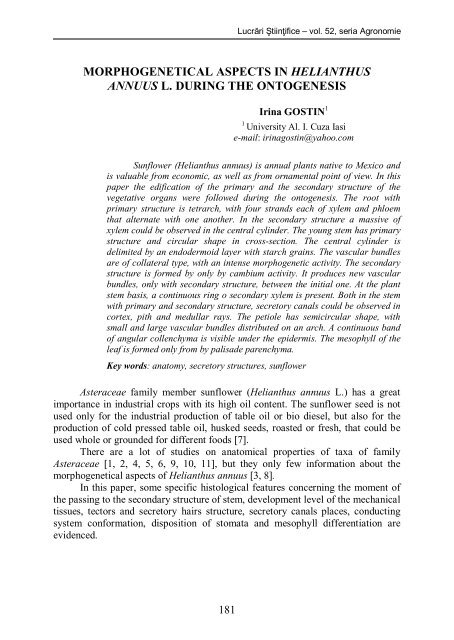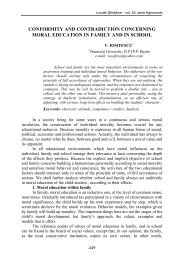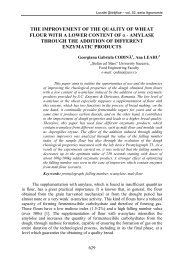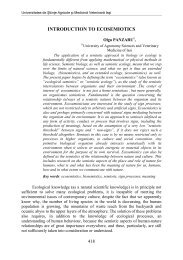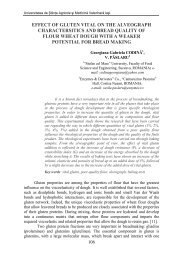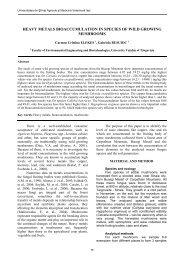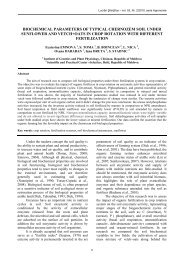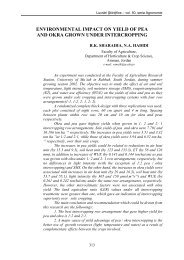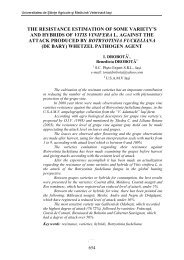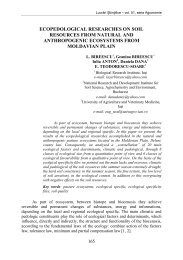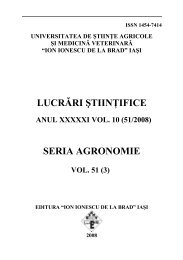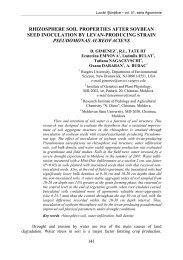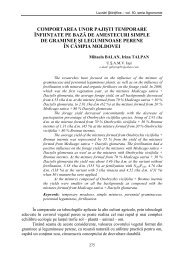morphogenetical aspects in helianthus annuus l. during the ...
morphogenetical aspects in helianthus annuus l. during the ...
morphogenetical aspects in helianthus annuus l. during the ...
Create successful ePaper yourself
Turn your PDF publications into a flip-book with our unique Google optimized e-Paper software.
Lucrări Şti<strong>in</strong>ţifice – vol. 52, seria Agronomie<br />
MORPHOGENETICAL ASPECTS IN HELIANTHUS<br />
ANNUUS L. DURING THE ONTOGENESIS<br />
Ir<strong>in</strong>a GOSTIN 1<br />
1<br />
University Al. I. Cuza Iasi<br />
e-mail: ir<strong>in</strong>agost<strong>in</strong>@yahoo.com<br />
Sunflower (Helianthus <strong>annuus</strong>) is annual plants native to Mexico and<br />
is valuable from economic, as well as from ornamental po<strong>in</strong>t of view. In this<br />
paper <strong>the</strong> edification of <strong>the</strong> primary and <strong>the</strong> secondary structure of <strong>the</strong><br />
vegetative organs were followed dur<strong>in</strong>g <strong>the</strong> ontogenesis. The root with<br />
primary structure is tetrarch, with four strands each of xylem and phloem<br />
that alternate with one ano<strong>the</strong>r. In <strong>the</strong> secondary structure a massive of<br />
xylem could be observed <strong>in</strong> <strong>the</strong> central cyl<strong>in</strong>der. The young stem has primary<br />
structure and circular shape <strong>in</strong> cross-section. The central cyl<strong>in</strong>der is<br />
delimited by an endodermoid layer with starch gra<strong>in</strong>s. The vascular bundles<br />
are of collateral type, with an <strong>in</strong>tense morphogenetic activity. The secondary<br />
structure is formed by only by cambium activity. It produces new vascular<br />
bundles, only with secondary structure, between <strong>the</strong> <strong>in</strong>itial one. At <strong>the</strong> plant<br />
stem basis, a cont<strong>in</strong>uous r<strong>in</strong>g o secondary xylem is present. Both <strong>in</strong> <strong>the</strong> stem<br />
with primary and secondary structure, secretory canals could be observed <strong>in</strong><br />
cortex, pith and medullar rays. The petiole has semicircular shape, with<br />
small and large vascular bundles distributed on an arch. A cont<strong>in</strong>uous band<br />
of angular collenchyma is visible under <strong>the</strong> epidermis. The mesophyll of <strong>the</strong><br />
leaf is formed only from by palisade parenchyma.<br />
Key words: anatomy, secretory structures, sunflower<br />
Asteraceae family member sunflower (Helianthus <strong>annuus</strong> L.) has a great<br />
importance <strong>in</strong> <strong>in</strong>dustrial crops with its high oil content. The sunflower seed is not<br />
used only for <strong>the</strong> <strong>in</strong>dustrial production of table oil or bio diesel, but also for <strong>the</strong><br />
production of cold pressed table oil, husked seeds, roasted or fresh, that could be<br />
used whole or grounded for different foods [7].<br />
There are a lot of studies on anatomical properties of taxa of family<br />
Asteraceae [1, 2, 4, 5, 6, 9, 10, 11], but <strong>the</strong>y only few <strong>in</strong>formation about <strong>the</strong><br />
<strong>morphogenetical</strong> <strong>aspects</strong> of Helianthus <strong>annuus</strong> [3, 8].<br />
In this paper, some specific histological features concern<strong>in</strong>g <strong>the</strong> moment of<br />
<strong>the</strong> pass<strong>in</strong>g to <strong>the</strong> secondary structure of stem, development level of <strong>the</strong> mechanical<br />
tissues, tectors and secretory hairs structure, secretory canals places, conduct<strong>in</strong>g<br />
system conformation, disposition of stomata and mesophyll differentiation are<br />
evidenced.<br />
181<br />
181
Universitatea de Şti<strong>in</strong>ţe Agricole şi Medic<strong>in</strong>ă Veter<strong>in</strong>ară Iaşi<br />
MATERIAL AND METHOD<br />
Vegetal material <strong>in</strong>vestigated from histo-anatomic po<strong>in</strong>t of view was preserved<br />
from a cultivated field near Iasi city. It consists <strong>in</strong> whole plants, <strong>in</strong> different stages of<br />
ontogenesis. All plants were been fixed and preserved <strong>in</strong> ethylic alcohol 70%. The<br />
sections made with free hand us<strong>in</strong>g a razor blade and colored with ru<strong>the</strong>nium red and<br />
methylen-blue. At this species <strong>the</strong> anatomical longitud<strong>in</strong>al symmetry phenomenon was<br />
evidenced. The photos were made after <strong>the</strong> obta<strong>in</strong>ed permanent slides us<strong>in</strong>g an<br />
Olympus BX51 microscope with an Olympus E-330 digital photo camera.<br />
RESULTS AND DISCUSSIONS<br />
The root with primary structure is tetrarch with 4 strands of xylem and 4<br />
strands of phloem (fig. 1a). The secondary structure is generated from <strong>the</strong> vascular<br />
and cork cambium activity. The vascular cambium arises from a comb<strong>in</strong>ation of<br />
<strong>the</strong> procambium and pericycle cells. The cork cambium is formed entirely from<br />
pericycle cells (fig. 1b). Secretory canals occur on <strong>the</strong> <strong>in</strong>ner cortex and phloem, but<br />
<strong>the</strong>y may also occur <strong>in</strong>ternally to <strong>the</strong> endodermis, associated with <strong>the</strong> pericycle;<br />
<strong>the</strong>se situations have been recorded <strong>in</strong> two species of <strong>the</strong> tribe Helian<strong>the</strong>ae [6].<br />
The stem is circular <strong>in</strong> cross section at all analyzed levels (fig. 1c, 2a, c). The<br />
epidermis shows numerousness large non-glandular and glandular hairs (fig. 1c).<br />
Under <strong>the</strong> epidermis, 8-11 layers of angular collenchyma could be observed (fig.<br />
1d, e, 2b). The cells have visible thick walls at <strong>the</strong>ir corners; between cells,<br />
especially <strong>in</strong> <strong>the</strong> <strong>in</strong>ternal part, some <strong>in</strong>tercellular spaces are visible. The<br />
endodermis is s<strong>in</strong>uous, more visible near <strong>the</strong> vascular bundles; between bundles,<br />
isolate islands of phloemic tissue could be observed (fig. 1e, f).<br />
The stem with primary structure conta<strong>in</strong>s collateral type vascular bundles<br />
arranged cyclically. At <strong>the</strong> top of <strong>the</strong> stem, an undifferentiated mechanic tissue<br />
protects each bundle (fig. 1d). In <strong>the</strong> secondary structure, this tissue will become a<br />
sclerenchyma (fig. 2a, c). In <strong>the</strong> cortex and <strong>in</strong> <strong>the</strong> pith, secretory canals, with a tight<br />
or large lumen and 4-10 epi<strong>the</strong>lial cells could be observed (fig. 1c, d, 2c, d, e). The<br />
organization of secretory structures <strong>in</strong> Asteraceae has been extensively studied by<br />
Col (1904) [2]. He recognized two dist<strong>in</strong>ct types of secretory canals: <strong>the</strong> secretory<br />
canal itself, which is always formed near <strong>the</strong> endodermis, and secretory purses,<br />
which are wider and shorter than <strong>the</strong> canals, and have <strong>the</strong>ir cavity surrounded by<br />
secretory cells.<br />
The secondary structure is formed by only by cambium activity. It produces<br />
new vascular bundles, only with secondary structure, between <strong>the</strong> <strong>in</strong>itial one. At<br />
this level only <strong>the</strong> secondary phloem is functional (fig. 2f).<br />
The petiole is semicircular <strong>in</strong> cross section, with rounded angles. In<br />
hypodermic position angular collenchyma could be observed (fig. 3a).<br />
The midrib is visible prom<strong>in</strong>ent on <strong>the</strong> adaxial and abaxial sides, both <strong>in</strong> young and<br />
ma t u r e lea ves ( f i g. 3b , d ). T he you n g lea ves ar e cover ed wit h<br />
182<br />
182
Lucrări Şti<strong>in</strong>ţifice – vol. 52, seria Agronomie<br />
Figure 3 a, b cross sections through <strong>the</strong> root: a – primary structure, b – secondary<br />
structure; c –cross sections through <strong>the</strong> top of <strong>the</strong> stem, d - detail, e – detail from a<br />
s e c r e t o r y c a n a l , f – d e t a i l f r o m a v a s c u l a r b u n d l e ( o r i g i n a l )<br />
numerousness tector and secretory hairs (fig. 3b, c). Their number decrease visibly<br />
on <strong>the</strong> mature leaf (fig. 3d, e).<br />
Upper and lower epidermis has large cells; <strong>the</strong> stomata are present <strong>in</strong> both<br />
epidermises (amphystomatic leaf with anomocytic stomata). The leaf has bifacial<br />
isofacial structure; <strong>the</strong> mesophyll is formed only from palisade parenchyma. The<br />
length of <strong>the</strong> palisade cells decrease from <strong>the</strong> upper to <strong>the</strong> lower epidermis.<br />
183<br />
183
Universitatea de Şti<strong>in</strong>ţe Agricole şi Medic<strong>in</strong>ă Veter<strong>in</strong>ară Iaşi<br />
Figure 2 Cross sections through <strong>the</strong> stem: a – middle part of <strong>the</strong> stem, b – detail from<br />
<strong>the</strong> subepidermic collenchyma, c – basal part of <strong>the</strong> stem, d, e – details with secretory<br />
canals, f – detail from primary (crushed) and secondary (functional) xylem (orig<strong>in</strong>al)<br />
At <strong>the</strong> ribs level, secretory canals could be observed (fig. 3f). They are<br />
miss<strong>in</strong>g from <strong>the</strong> leaf lam<strong>in</strong>a. The vascular bundles from ribs have only primary<br />
structure (fig. 3f).<br />
184<br />
184
Lucrări Şti<strong>in</strong>ţifice – vol. 52, seria Agronomie<br />
Figure 3 a Cross section through <strong>the</strong> petiole; b, c – cross sections through <strong>the</strong> young<br />
leaf: b – detail from midrib, c – detail from lam<strong>in</strong>a; d-f – cross sections through<br />
mature leaf: d – midrib, e – detail from lam<strong>in</strong>a, f – detail from midrib (orig<strong>in</strong>al)<br />
185<br />
185
Universitatea de Şti<strong>in</strong>ţe Agricole şi Medic<strong>in</strong>ă Veter<strong>in</strong>ară Iaşi<br />
CONCLUSIONS<br />
Helianthus <strong>annuus</strong> is an annual plant with a rapid grow rate; this fact is<br />
supported by <strong>the</strong> <strong>in</strong>tense activity of <strong>the</strong> meristematice tissues (both <strong>in</strong> primary and<br />
<strong>in</strong> secondary structure). The roots acquire quickly secondary structure and rapidly<br />
<strong>in</strong>crease <strong>the</strong> uptake rate of <strong>the</strong> water from <strong>the</strong> soil. The stem has primary structure<br />
only at <strong>the</strong>ir top and only <strong>in</strong> young plants. The secondary structure assures <strong>the</strong><br />
necessary resistance for <strong>the</strong> susta<strong>in</strong>ability of <strong>the</strong> <strong>in</strong>florescence. At <strong>the</strong> flower<strong>in</strong>g<br />
stage, <strong>the</strong> stem has secondary structure <strong>in</strong> all <strong>the</strong>ir length. The leaves have isofacial<br />
structure and <strong>the</strong> mesophyll consist only <strong>in</strong> palisade parenchyma. It assure <strong>the</strong> best<br />
photosyn<strong>the</strong>sis rate because <strong>the</strong>ir structural peculiarities.<br />
BIBLIOGRAPHY<br />
1. Appezzato-Da-Glória, B., Hayashi, A.H., Cury, G., Soares, M.K.M., Rocha, R., 2008 -<br />
Occurrence of secretory structures <strong>in</strong> underground systems of seven Asteraceae<br />
species, Bot. J. L<strong>in</strong>n. Soc., vol.157, p. 789–796.<br />
2. Col, M., 1904 - Recherches sur l'appareil sécréteur <strong>in</strong>terne des Composées. Journal de<br />
Botanique, vol. 18, p. 153-175.<br />
3. Fambr<strong>in</strong>i, M., Bonsignori, E., Rappar<strong>in</strong>i, B., Cion<strong>in</strong>i, G., Michelotti, V., Bert<strong>in</strong>i, D., Baraldi,<br />
R., Pugliesi, V., 2006 - Stem fasciated, a Recessive Mutation <strong>in</strong> Sunflower<br />
(Helianthus <strong>annuus</strong>), Alters Plant Morphology and Aux<strong>in</strong> Level, Ann. Bot., vol.98, nr.<br />
4, p. 715 - 730.<br />
4. Gost<strong>in</strong>, I., Toma C., Ivanescu L., 2000 – Secretory structures at Chrysan<strong>the</strong>mum<br />
balsamita dur<strong>in</strong>g <strong>the</strong> ontogenesis, In: 2nd Mediterranean Meet<strong>in</strong>g "New Perspectives<br />
<strong>in</strong> Controlled Release", A<strong>the</strong>na (Greece): p. 2047-2053.<br />
5. Gost<strong>in</strong>, I., 2001 – Seedl<strong>in</strong>g structure of Chrysan<strong>the</strong>mum balsamita L An. şt. Univ. Iaşi, s. II<br />
a Biol. Veget., vol. 47, p. 41-49.<br />
6. Hoehne, W., Grotta, A.S., Scavone, O., 1952 - Contribuição ao estudo morfológico e<br />
anatômico de Calea p<strong>in</strong>natifida Banks., Anais da Faculdade de Farmácia e<br />
Odontologia da USP vol. 10, p. 9-33.<br />
7. Kocjan Ačko D., 2008 - Some economically important properties of sunflower cultivars<br />
(Helianthus <strong>annuus</strong> L.) <strong>in</strong> <strong>the</strong> field trials performed at Biotechnical faculty, Acta<br />
agriculturae Slovenica, vol. 91, nr. 1, p. 1854-1941.<br />
8. Mantese, A.J., Medan, D., Hall, A.J., 2006 - Achene structure, development and lipid<br />
accumulation <strong>in</strong> sunflower cultivars differ<strong>in</strong>g <strong>in</strong> oil content at maturity, Ann. Bot., vol<br />
97, p. 999–1010.<br />
9. Melo-de-P<strong>in</strong>na, G.F.A., and Menezes, N.L., 2003 - Meristematic endodermis and<br />
secretory structures <strong>in</strong> adventitious roots of Richterago Kuntze (Mutisieae-<br />
Asteraceae). Rev. bras. Bot., vol.26, nr.1, p.1-10.<br />
10.Metcalfe, C.R., Chalk, L., 1979 - Anatomy of Dicotyledons I. London: Oxford University<br />
Press.<br />
11. Saenz, A.A., 1981 - Anatomía y morfología de frutos de Helian<strong>the</strong>ae (Asteraceae),<br />
Darw<strong>in</strong>iana, vol. 23, p. 37–117.<br />
186<br />
186


